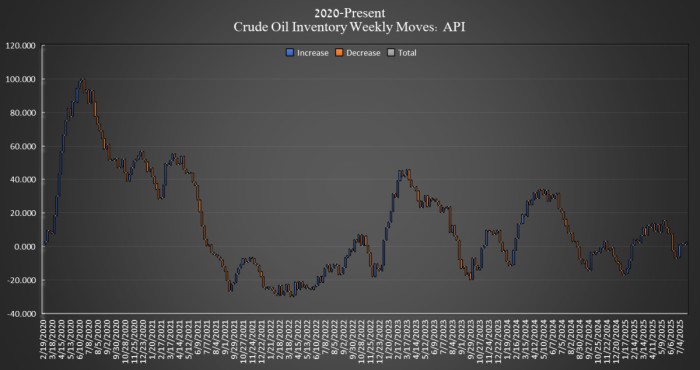The American Petroleum Institute (API) estimated that crude oil inventories in the United States rose this week, adding 1.539 million barrels in the week ending July 25. This is a stark constrast to the expected 2.5 million barrel draw that analysts had expected.
So far this year, crude oil inventories are up nearly 13 million barrels, according to Oilprice calculations of API data.

Earlier this week, the Department of Energy (DoE) reported that crude oil inventories in the Strategic Petroleum Reserve (SPR) saw another rare drop this week, adding 200,000 barrels to 402.7 million barrels in the week ending July 25, after rising by 200,000 in the week prior.
Inventory levels in the nation’s reserve have rebounded slowly over the last year, but are still hundreds of millions shy of the levels in inventory prior to the SPR withdrawal that took place under the Biden Administration.
At 3:32 pm ET, Brent crude was trading up $2.63 (+3.75%) on the day, landing at $72.67—up nearly $4 per barrel from last week’s prices.
WTI was also trading up on the day, by $2.60 (+3.90%) at $69.31.
Gasoline inventories fell in the week ending July 25 by 1.739 million barrels, after falling by 1.228 million barrels in the week prior. As of last week, gasoline inventories were slightly above the five-year average for this time of year, according to the latest EIA data.
Distillate inventories rose substantially again this week, by 4.189 million barrels after rising by 3.48 million barrels in the week prior. Distillate inventories were 19% below the five-year average as of the week ending July 18, the latest EIA data shows.
Cushing inventories—the benchmark crude stored and traded at the key delivery point for U.S. futures contracts in Cushing, Oklahoma—rose by 465,000 barrels in the week. In the week prior, Cushing inventories had risen by 314,000 barrels.
By Julianne Geiger for Oilprice.com
More Top Reads From Oilprice.com

